
Author: Flashbots Source: Flashbots Research Translation: Shan Oppa, Bitchain Vision
Wallet is the portal of Web3 and an important portal for users to send and receive messages, manage funds, and interact with blockchain applications.As an important part of blockchain infrastructure, wallets have a significant impact on users’ Web3 experience.
The wallet ecosystem is diverse, and providers provide a variety of products and services through different mechanisms.As wallet providers strive to achieve sustainability and diversification, their operating models are also evolving, creating new dynamics between users, applications and underlying blockchain infrastructure.
Our report aims to clarify the current status of wallets on Ethereum based on research conducted by orderflow.art.
However, identifying wallets through on-chain transaction tracking faces several challenges:
-
The identification is incomplete due to unknown router or signature address.
-
It is difficult to identify multiple wallet addresses related to centralized exchanges.
-
Some wallets lack router addresses, which makes it difficult for users to identify.
Despite these limitations, this report provides a comprehensive overview of Ethereum wallets, current trends and future prospects.
The report begins with a background section and covers two key areas: wallet classification and order flow lifecycle.In the wallet category, we divide Web3 wallets into managed and unmanaged types, detailing various forms of unmanaged wallets.The Order Flow Lifecycle section outlines the transaction’s journey and identifies key players from the order flow initiator to the block builder.
Next, we will explore current trends, focusing on the latest developments that affect order flow initiators (OFOs).We examine the impact of the increasing centralization of the block construction market, which intensifies competition in order flow.This section covers three key concepts: Order Flow Payment (PFOF), Order Flow Auction (OFA), and Private Order Flow (POF).In addition, we introduce Account Abstraction (AA), with a special focus on ERC-4337, a major development in reshaping the wallet landscape.
Finally, in future trends, we explore developments aimed at enhancing user experience and addressing regulatory challenges in the wallet space.We have studied pre-confs, a mechanism designed to increase transaction confirmation speed.We also analyzed two Ethereum Improvement Proposals (EIPs) designed to enhance account abstraction.In addition, we discuss Trusted Execution Environment (TEE) and its role in improving the security and privacy of Web3 wallets.We considered how TEE is a potential compliance solution for the crypto industry, especially when regulatory focus shifts from decentralization to control issues.
background
introduce
Wallet is the main interface for users to interact with blockchain applications.While users often maintain multiple wallets (for example, multiple MetaMask accounts), the process of migrating private keys to a new wallet provider is often cumbersome.This lack of user-friendly portability has a “sticky” effect, which often binds users to existing wallet providers.
The increasingly fierce competition in order flow makes it increasingly important for wallet providers to acquire and retain users.This competitive landscape has spawned an interesting trend: Decentralized finance (DeFi) applications such as Uniswap, 1inch and Curve Finance are now creating their own wallets.This strategic move allows these DeFi platforms to better control the user’s order flow, which will potentially gain more value and provide a more integrated user experience.
This trend highlights the evolution of the relationship between users, wallets, and DeFi applications in the blockchain ecosystem.It highlights how the order flow battle reshapes the wallet landscape and influences the strategies of major players in the DeFi space.
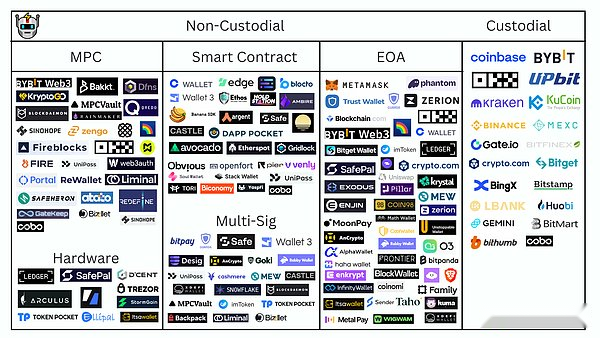
Wallet Classification
Web3 wallets are usually divided into managed (controlled by third parties) and unmanaged (controlled by users).Control is who holds the private key of the wallet.
-
Hosted Wallet: Hosted wallets are mainly provided by cryptocurrency exchanges and Telegram bots, which save users’ private keys and provide users with a better user experience.However, users do not have complete control over their own funds, and these third parties may access users’ funds without their permission.
-
Unmanaged Wallet: The user holds the private key and has complete control over the unmanaged wallet.If the private key is lost, the user will not be able to access the wallet and funds.The private key of the hot wallet is stored on a networked device that interacts with the application.Cold wallets store private keys on dedicated isolated hardware devices that do not interact with the application.Unmanaged “hot” wallets are connected to the internet and are usually accessed through browser extensions, mobile apps, or desktop apps.The “cold” wallet has no online access and the assets are stored in a physical device.
There are different types of unmanaged wallets, using different technologies to improve user experience and security.
MPC wallet
Multi-party computing (MPC) wallets use encryption to encrypt, segment and distribute private keys to multiple devices.These devices or parties must evaluate the calculation without revealing their private keys or data.Multi-party computing protocols used in MPC wallet environments usually have the following properties:
-
Threshold security: Ensure that a predefined number of participants must cooperate to sign the transaction.
-
Key Fragment: The ability to split a private key into multiple shares.
-
Distributed key generation: Generate keys in a distributed manner so that no party knows the complete private key.
The benefits of MPC wallet are:
-
Security: Since no one controls the private key, an attacker needs to attack multiple parties, thereby increasing the security of the wallet.
-
Recoverability: By storing the encryption key fragment in multiple places, the authorized party can recover the account if the key is lost.
-
Accessibility: As private key fragments are securely distributed among multiple parties, assets can be held online.Transactions can be executed more efficiently than hot wallets without compromising the security of the keys.
External Ownership Account (EOA)
External Ownership Account (EOA) is managed by a user-controlled unique private key to interact with smart contracts on the chain.
EOA uses a private elliptic curve digital signature algorithm (ECDSA) key to sign and verify digital transactions.Users can send and receive transactions, interact with smart contracts, and approve messages through EOA.
To create an EOA, the wallet UI generates a private key and a seed phrase.Since there is only one private key and seed phrase, if the user loses both the private key and seed phrase, they will not be able to access their wallet.
Smart contract wallet
Smart Contract Wallets or Smart Wallets utilize account abstraction and programmability of smart contracts to improve user experience.Smart contract wallets are not controlled by private keys, but by contract codes.Account abstract protocols like ERC-4337 can help smart contract wallets bypass the requirement of EOA wallets to initiate transactions.Smart contract wallets can be programmed to implement the following functions:
-
Two-factor authentication
-
Account freeze
-
Flexible recovery
-
Transaction batch processing
-
Transfer and consumption restrictions
-
Session Key
-
Gas sponsorship and non-native tokens Gas payment
-
Multi-signature wallet
Compared to EOA, smart contract wallets have less gas overhead, which is mainly due to execution of contract code and publishing events.Compared with EOA, smart contracts are inherently more complex and powerful, so only smart contract wallets that have been tested by audit and practical operations are trustworthy.
Order flow life cycle
Orderflow.art clarifies order flow conditions and identifies known on-chain participants during the transaction life cycle.
The life cycle of the transaction begins with the front end of the chain on the left side of the Sanki chart of the order flow, and finally the block builder on the right.
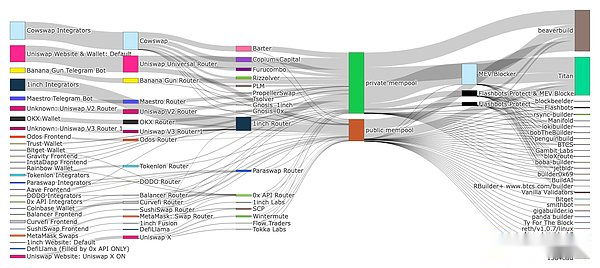
The key chain participants in the transaction life cycle are:
Order flow initiator
Order Flow Initiator (OFO) is the first on-chain application to interact with the wallet.OFO includes:
-
Wallet: Wallet is constantly adding more features to improve user experience, such as direct exchange.
Note: Figures 3, 4, and 5 include only known routers and underestimate native exchange transactions for wallets.
-
Front-end: Uniswap and other applications have their own wallets and interfaces for users to create transactions.The DEX front end is losing dominance in terms of both transaction volume and transaction volume market share (Figure 3 and Figure 4).
-
Telegram Bots: Banana Gun, Maestro and Unibot have accounted for a large portion of retail transactions over the past year (Figure 4).Transaction sizes are usually less than $10,000 (Figure 5).
-
Aggregators: Aggregators are applications such as DefiLlama, Matcha, 0x API, and 1inch API that connect to multiple DEXs to uniformly disperse liquidity.Since 2023, trading count market share has remained relatively stable, while trading volumes have declined slightly (Figures 3 and Figure 4).
-
Order Stream Auction: OFA includes solver batch auctions (e.g. CoWSwap), RFQ systems (e.g. Uniswap X), and execution auctions (e.g. MEV-Blocker).OFA has been gaining volume market share at the expense of the DEX front end (Figure 3) and is often used for larger transactions (Figure 5).
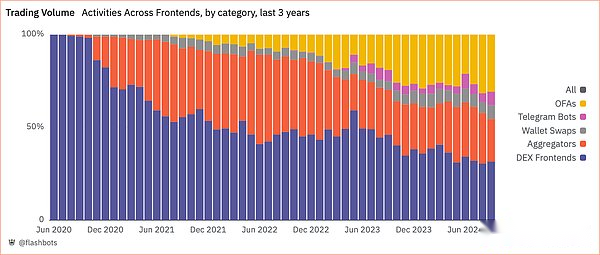
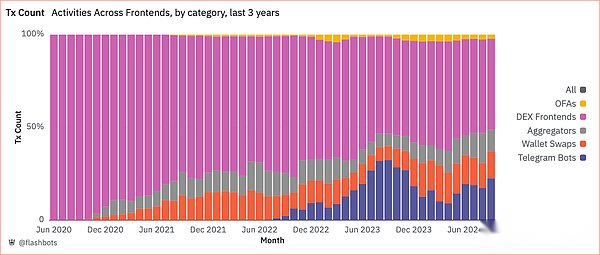

Liquidity provider
Large transactions or transactions involving non-liquid trading pairs are usually routed to Order Stream Auction (OFA) and aggregators to minimize slippage.These providers obtain liquidity from multiple decentralized exchanges (DEX), off-chain sources and proprietary inventory.
-
Market Maker: Trading entities that use off-chain liquidity and own inventory to execute transactions.They provide liquidity for quotation request (RFQ) platforms such as Hashflow and Uniswap X.
-
Solution: Determine the best routing and pricing of transaction execution.Solutions are used for OFAs such as CoWSwap, and some solutions provide direct user transaction submissions through their own front-end interface.
-
CEX-DEX Searchers: These searchers use off-chain liquidity from centralized exchanges (CEXs) to capture on-chain arbitrage opportunities.They can take advantage of OFA with private memory pools such as MEV Share and MEV-Blocker.
Memory pool
Ethereum orders are submitted to public or private memory pools:
-
Public Memory Pool: Transactions are visible to everyone, and searchers and OFAs can pick them up and package them.All block builders have access to these transactions to be included in the block.
-
Private Memory Pool: Transactions are visible to selected parties only, including specific searchers, OFAs, and builders.
Builder
The builder arranges and incorporates transactions into the block.If the transaction is included in the winning builder’s block, the life cycle of the order is completed.If not included in the winning block, the transaction will remain in the memory pool until it is included in the future block or discarded.
Current Trends
The Ethereum landscape is currently showing several major trends in reshaping the industry.The two major trends of Ethereum that affect order flow initiators are 1) centralization of the blockchain market, and 2) using ERC-4337 to achieve account abstraction.
Block generator centralization
The builder market for Ethereum is becoming increasingly concentrated, with two builders accounting for more than 90% of the block market.

This concentration leads to new dynamics in order flow:
-
Order flow payment (PFOF)
-
Order Flow Auction (OFA)
-
Private order flow
These mechanisms are changing how transactions are processed and prioritized, providing benefits such as MEV protection and improving price discovery, but also raising concerns about market equity and decentralization
Order flow payment
Pay by order flow (PFOF) is a traditional financial concept in which market makers initially pay brokers for over-the-counter order flow fees.Market makers believe that retail order flow is ignorant and harmless and that transactions are profitable.With the expansion of the automated trading system (ATS), market makers use PFOF to attract retail orders to their ATS.
There are three ways retail traders can benefit from PFOF:
-
Part of the PFOF is used to cover the execution costs of retail traders.
-
Market makers will provide stricter quotes, allowing retail traders to execute transactions at a more favorable price
-
Market makers will be able to provide greater liquidity for zero-stock orders.
In Ethereum, PFOF has become the exclusive order flow (“EOF”) relationship between the order flow initiator (“OFO”) and the builder.EOF bypasses public memory pools and accounts for up to 35% of the market share.Exclusive order flow enables builders to build blocks of higher value than competitors, who can only get transactions from public memory pools or order flow auctions (“OFA”).Since EOF requires enforcement assurance, builders will multiplex the bundle of OFO to ensure timely inclusion.
There are several reasons why order flow initiators use the EOF relationship:
-
Block inclusion guarantee.By working with top builders, OFO increases the probability that its transactions will be included in the next build block.
-
User MEV protection.OFO almost eliminates the MEV of its transactions.
-
Priority refund of gas fees.OFO can receive a refund of the preferred gas fee paid by the user.Builders value high-quality transactions, such as grabbing orders from Telegram bots and are willing to pay more for this order flow.
Currently known EOF relationships:
-
Banana Gun and Titan Builder
-
Master and Beaver

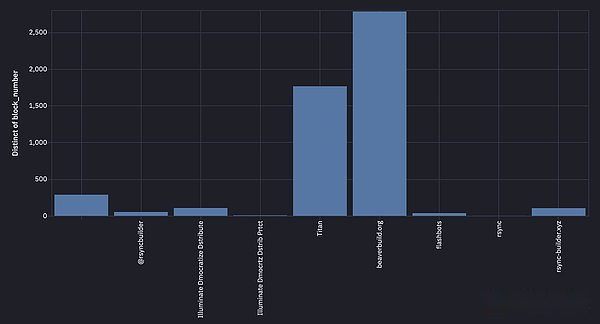
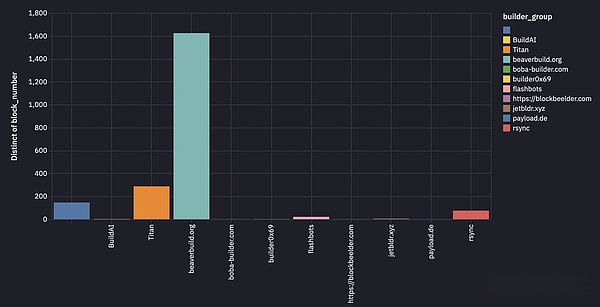
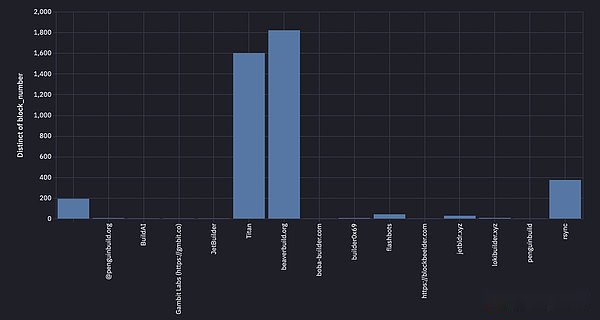
* EOF is calculated approximately by order flow not seen in Flashbots or memory pools.
Orders are sold out
Order Stream Auction (OFA) is created to protect user transactions from negative MEV strategies such as preemptive transactions and mezzanine attacks.OFA provides many benefits to users, including:
-
Reduce transaction costs.OFA bundled transactions, thereby reducing gas fees and reducing execution errors.
-
MEV refund.OFA can auction MEV repurchase opportunities and return partially captured MEV to the user.
-
Improve price discovery.Third-party solutions compete for the best execution price.
-
Enhance liquidity.Third-party solutions can aggregate liquidity from a wide range of sources such as DEX, CEX and private inventory.

OFA summarizes swap transactions from multiple users and auctions them to third-party bidders for execution.OFA acts as an auctioneer and selects winning bids based on predefined criteria.Winning bids are submitted to block builders on-chain in a bundled form for consensus.
There are many types of OFA:
-
Quotation Request (RFQ): RFQ submits bids using on-chain and private inventory using pre-selected bidders, funds and market maker systems.RFQ provides better liquidity than public automatic market makers (AMMs), because RFQ market makers have access to other liquidity sources such as CEX and cross-chain AMMs.Examples: UniswapX, Bebop, 1inch Fusion, Hashflow, 0xAPI
-
Frequent bulk auctions: Frequent bulk auctions enable third-party solutions to optimize prices and liquidity while protecting transactions from MEVs.Transactions are bundled together, saving gas and improving execution rates.Examples: CoWSwap, DFlow
-
Transaction Execution Auction: Third-party bidders (especially searchers) extract MEVs and compete for the highest user refunds.This OFA is usually integrated directly with the wallet via RPC.Examples: MEV-Blocker, Merkle
-
Block Space Aggregator Auction: Block Space Aggregator Auction returns value to the original user through builder-first gas rebates.Builders compete to include transaction packages to increase the value of their blocks and will refund the portion of the transaction package payments to be preferred.Example: Flashbots MEV Share
Private Order Process
Private Order Flow (POF) is an order flow from vertically integrated order flow initiators (wallets, applications, solvers, searchers) and builders.This stream is not usually multiplexed and sent to a single builder.
Top builders Beaver Build and Rsync integrate with proprietary trading companies SCP and Wintermute and benefit from the in-house CEX-DEX order flow.Integrated search builders have an advantage over average builders because their searcher’s profits can be redistributed to builders, thereby increasing the likelihood of submitting winning block bids.Integrated search builders also benefit from latency savings when sending transactions from searchers to builders.This delay saving can be extended to block builder auctions.

(a) https://arxiv.org/pdf/2407.13931.EOF for Titan(b), Beaverbuild(c), and Rsync builder(d).Note that only Rsync can see the Wintermute private order flow, and only Beaverbuild can see the SCP private order flow.
Future impact
OFAs such as Flashbots Protect and MEV-Blocker have provided RPCs for users to integrate into their wallets.These products are mainly for personal wallet users to opt in and are directly integrated into the application.
Additionally, wallets have begun to capture the value of their order flow.
-
Metamask Smart Trading – Metamask Smart Trading executes the same features as OFA, providing MEV protection, gas refund and recovery protection.This service is automatically integrated into Metamask’s wallet for users to choose from.Searchers and solvers pay to access smart transaction order flows.
-
Trust Wallet MEV Protection – Trust Wallet MEV Protection is provided to users by default, but does not include gas refund and restore protection.
Account abstraction
The implementation of account abstraction, especially through ERC-4337, is revolutionizing user interaction with blockchain networks by introducing smart contract wallets and new entities such as Bundlers and Paymasters.These developments not only enhance the user experience, but also create new opportunities and challenges in transaction processing and fee structure.
ERC-4337
The main goal of account abstraction is to eliminate the need for all users to have EOA and allow users to use a smart contract wallet as their primary account.Account abstraction does this by separating account management and transaction execution from EOA.Account abstraction uses new entities: 1) Bundler, used to initiate transactions; 2) Paymaster, used to determine gas payment policies.

ERC-4337 introduces two new players – Bundler and Paymaster:
-
Bundler – Bundler combines multiple user operations into a transaction, similar to a block generator, and submits the transaction to the entry point contract execution.More importantly, Bundler owns EOA, allowing them to initiate transactions, eliminating the need for users to own EOA wallets.Current bundlers include Skandha, Alchemy, Rundler, Voltaire, Alto, Stackup, and Infinitism.
-
Paymaster – Paymaster is a smart contract that handles wallet gas payment policies.Paymaster determines which currency (stablecoins or other ERC-20 tokens) can be used for gas payments and allows applications to pay gas fees for their users.
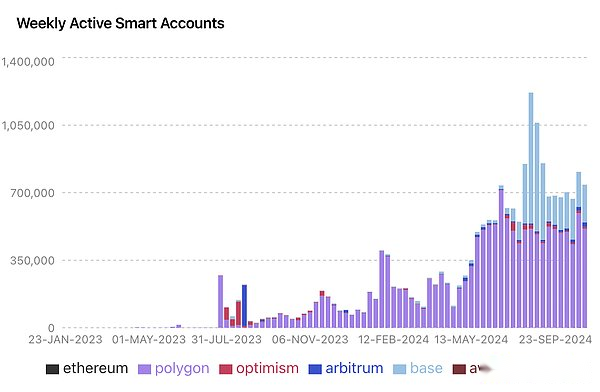
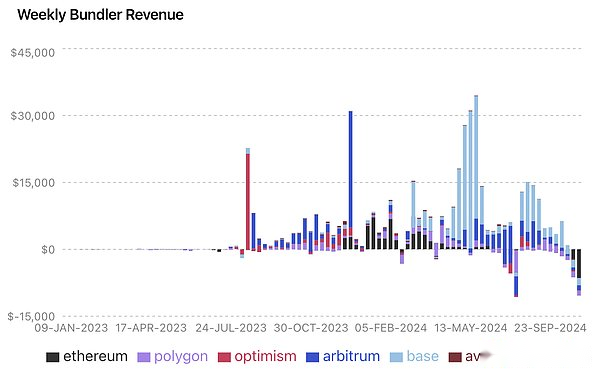
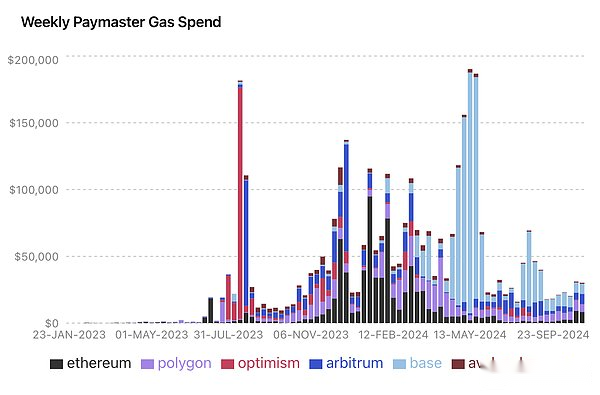
Future impact
According to ERC-4337, the bundler’s status is similar to today’s block builders, allowing you to perform exclusive order-flow transactions using a smart contract wallet.Exclusive order flow is even more important for bundlers as they compete for the highest priority fee, while failed bundlers pay the gas cost of restoring UserOperation.
Because the UserOperation memory pool is public, UserOperations are vulnerable to preemptive transactions and mezzanine attacks.Bundlers can capture some MEVs because they sort UserOperations and batch them into a bundle.Searchers can run a bundler to extract MEVs from the exposed UserOperation memory pool.Bundlers and builders can be integrated to get additional order flow.
Future trends
Driven by technological innovation and regulatory development, the cryptocurrency and blockchain fields are at the forefront of major transformation.Key trends that shape the future include:
-
Confirm in advance to increase transaction speed.
-
EIP-7702 and EIP-7212 are used for account abstraction and smart wallet improvements to enhance user experience and transaction signature standards.
-
Integrate Trusted Execution Environment (TEE) for enhanced security.
-
Regulatory discussions, especially those around stablecoins and securities, are driving the industry to adapt within the new legal framework.
As the focus shifts from broad decentralization to a meticulous discussion of control and execution, these trends promise to redefine how users interact with blockchain networks, how developers build applications, and how ecosystems respond to regulatory challenges.
Pre-confirm
Preconfs (“preconfs”) is a research proposal that allows users to receive transaction confirmation before transactions are confirmed by consensus.Pre-confirmation is designed to improve user experience by eliminating high network congestion on Ethereum, Layer 2 aggregation and verification with faster confirmation.The pre-confirmation-based proposal was first proposed by Justin Drake, allowing L1 proposers to provide economic assurances that will be included in L2 user transactions.

How does preconfiguration work?
-
Ethereum block proposers (“prenegotiators”) or representatives sign a commitment to users to ensure that their transactions will be incorporated and executed faster than expected L1 consensus.
The field of pre-confirmation is still in its early stages and several different approaches have been proposed.The following methods may have the greatest impact on order flow initiators:
-
XGA Style Pre-Confirmation: XGA Style Pre-Confirmation Guarantee (non-position) transaction packages are included at the bottom of the block.Fill transactions (no immediate execution or low MEV transactions) can be included in the bottom transaction package at the block.This allows builders to focus on valuable block top MEV transactions and simplify gas pricing for fill transactions.
-
Primev’s MEV-Commit: MEV-commit is a P2P network that promises to execute Ethereum transactions and rewards or cuts providers.The order flow initiator (“Bidder”) specifies its transaction execution intention to the provider.
-
Espresso’s BFT Pre-Confirmation: BFT Pre-Confirmation is supported by the security and activity assurance of the BFT consensus algorithm.BFT pre-confirmation is supported by a subset of L1 validators, rather than by a single validator as it is based on pre-confirmation.
Future impact
Because order flow initiators can guarantee transaction execution at higher fees, pre-configuration will lead to a better execution experience.
For XGA style presets, including non-delay sensitive transactions (i.e., “governance,” “interest,” “authorization,” “declaration”) at the bottom of the block can reduce the gas consumed by these exchanges and reduce the amount of gas caused by insufficient gasnumber of transaction revocations.
EIP-7702 and EIP-7212
There are two account abstract EIPs that can fully unlock the potential of smart contract wallets and become a game changer in the wallet ecosystem.
EIP- 7702
EIP-7702 introduces the following features for EOA:
-
Batch processing: Users can perform multiple operations in a single atomic transaction.
-
Sponsorship: A separate account X or application operator can pay for transactions in Account Y.Account X can receive ERC-20 tokens for this service.
-
Permission downgrade: The user signs a subkey that provides weaker specific permissions.For example, only interact with specific applications, only use certain ERC-20 tokens for transactions, and transfer restrictions.
EIP-7702 is designed to be backward and forward compatible with ERC-4337, allowing EOA to leverage existing ERC-4337 infrastructure.EOA can also temporarily convert itself into a smart contract wallet for inclusion in the ERC-4337 bundle.
The benefits of EIP-7702 include:
-
Reduce security risks: EIP-7702 also eliminates the central trust point when assigning smart contract codes to EOA for transactions.EIP-7702 There is no possibility of unauthorized transactions, because the contract code will be deleted after the transaction is executed.
-
dApp Easy to use: Applications using ERC-4337 can easily integrate with EIP-7702 without changing their code.EOA calls smart contracts without authorization.
EIP-7702 is still a new proposal, with some issues that developers need to consider:
-
Revocation: EIP-7702 does not have clear details about revoking the contract code when any malicious code is detected.
-
Chain agnostic signature: EIP-7702 uses a fixed signature and can be reused in other chains, but lacks flexibility if the user wants a different implementation.
EIP- 7212
EIP-7212 or RIP-7212 creates a signature verification contract using the “secp256r1” elliptic curve standard.The standard has been adopted by the largest Web2 companies for user authentication and can be integrated into the ERC-4337 smart contract wallet.
“secp256r1” is currently used for the following authentication applications:
-
Apple’s Secure Zone: Apple’s Secure Zone is the Trusted Execution Environment (TEE) hardware that creates and stores keys.Secure areas can encrypt or decrypt data, sign arbitrary messages, and can only be accessed through biometrics.
-
WebAuthn: Web authentication is the web standard for authentication used by most Web2 browsers (Chrome, Firefox, Edge, and Safari).WebAuthn uses domain-specific public key encryption for user authentication, eliminating passwords, providing faster recovery and reducing security risks.
-
Android Keystore: Android Keystore is a secure system credential store.Applications can create private and public keys and store them in the Keystore.Keystore is encrypted based on the user’s own mobile phone password and can be accessed through password or biometric technology.
-
Key: The key is a FIDO credential that allows users to access their account without a password using biometrics or PIN code.Users can access websites or applications by unlocking their mobile devices without passwords.
RIP-7212 is a summary version of EIP-7212, and the teams of Kakarot, Polygon, Optimism, zkSync, Scroll and Arbitrum have committed to implementing it.Polygon offers RIP-7212 on its test network, and Coinbase’s recently launched smart wallets include password verification.

How does a key work?
-
A smart contract wallet creates a password or public and private key pair.
-
The private key is stored in TEE on your mobile device.
-
When a smart contract wallet creates a pending transaction, users use biometrics or mobile PINs to authenticate to unlock the private key.
-
The mobile device then uses the private key to “sign” the transaction and sends the completed transaction back to the smart contract wallet.
-
This signature is verified on-chain by the RIP-7212 smart contract.
Future impact
While EIP-7702 is still in the proposal phase, RIP-7212 is actively integrating into the L2 Rollup and implementing it into the smart contract wallet.Passkey Wallet provides powerful features for the ERC-4337 smart wallet by eliminating the need for passwords and seed phrases and increasing security to the hardware level.Currently using Passkey includes:
-
Coinbase Smart Wallet: Coinbase’s smart wallet uses keys to authenticate users and sponsor gas transactions.Smart wallet supports 8 networks (Base, Ethereum, Optimism, Arbitrum, Polygon, Avalanche, BNB, Zora) and provides wallet SDK for dApps integration.
-
Clave: Clave uses mobile TEE and keys to provide gas fees for social recovery, account naming services, biometric login and sponsorship on zkSync.
-
Banana SDK: Banana’s SDK leverages WebAuthn to provide zero-knowledge 2FA, biometrics, and recovery accounts with nominees.
-
Turnkey: Turnkey is a wallet-as-a-service (WaaS) provider that stores private keys in TEE.
EIP- 712
EIP-712 is a typed message signature standard designed to allow off-chain message signatures to be used for on-chain signatures, thus providing a better user experience.Unlike reading byte strings, EIP-712 allows the display of signatures in a readable format without losing system security properties.Off-chain signatures save gas and reduce the number of on-chain transactions.
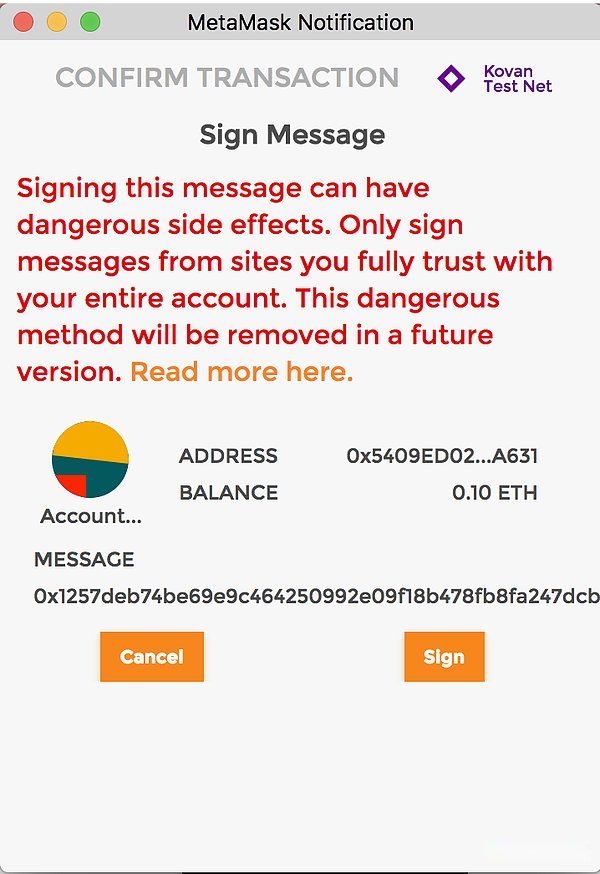
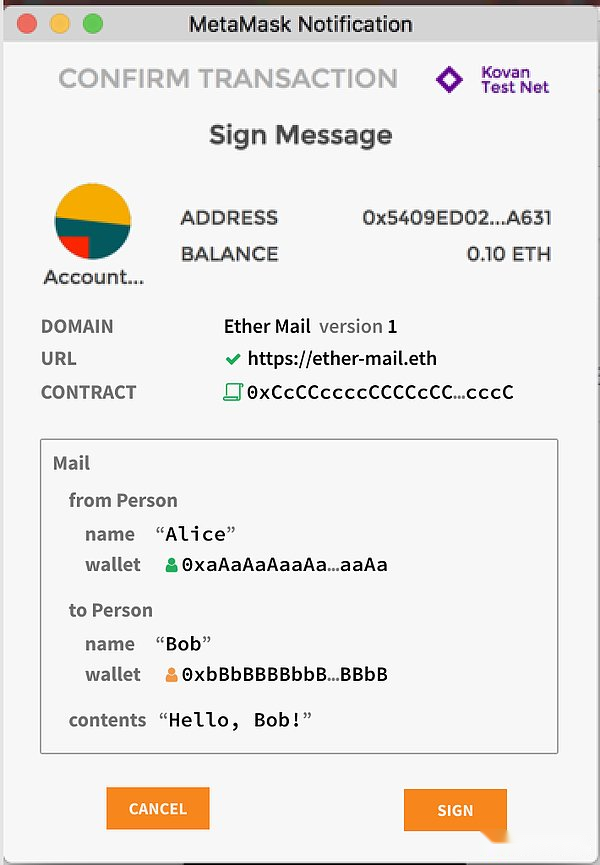
How does EIP-712 work?
-
dApps developers utilize user-signed JSON data structures.
-
Domain delimiters prevent signatures from being used on multiple dApps and allow multiple different signature use cases within a given dApp.
-
Wallet and front-end operators can parse dApp data structures and convert data into user-readable messages.
One of the key features of EIP-712 unlocking is that it allows dApps to control the transaction flow of users (rather than wallets).Applications like Uniswap can minimize user MEVs, as the exchange bypasses OFA and other MEV value extractors.
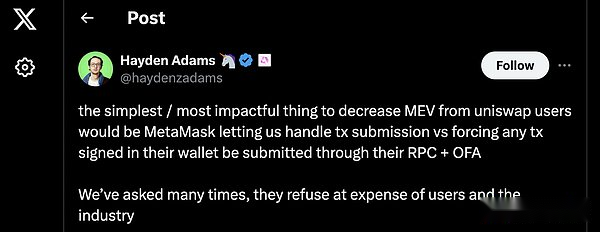
In addition to the readability of wallet transactions, EIP-712 also allows third parties to vote for gas fees for users, thereby increasing the availability of governance.Voters can use EIP-712’s signature feature to create signed delegation or voting transactions for free.
Future impact
In addition to wallet readability, EIP-712 can be used to improve user experience in other areas.
-
Governance.Users can entrust others to vote and allow third parties to pay gas fees for them through EIP-712’s signature feature.
-
Clear signature.A hardware wallet or a separate device can display a message from a dApp, ensuring that users can be sure that there is no malware or malicious application to send them the message.
-
Replay attack prevention.Data that prevents replay attacks can be included in EIP-712’s structured data.
-
MEV minimized.EIP-712 allows users to sign transactions while allowing the front-end to send order flows without broadcasting them to the network, minimizing users’ impacts by malicious MEVs.
Trusted Execution Environment (TEE)
Trusted Execution Environment (TEE) is a secure area based on a hardware microprocessor, where sensitive computing and operations can run intact and private.TEE supports isolation and remote authentication and can run virtual machines such as EVM and CosmWasm without encryption overhead such as multi-party computing (MPC) or zkSNARK.
For web3 wallets, mobile TEEs like Apple’s Secure Enclave and Google’s Titan M2 can better protect the private keys of smart contract wallets than standard hardware wallets.Users can create and store private keys within TEE and use these keys to sign transactions.The key is retained on the device and only the device owner can access it through biometric authentication or device PIN.
TEE is currently used in a variety of wallet solutions:
-
MPC: Fireblocks uses Intel SGX TEE to isolate encrypted data, MPC and ZKP encryption algorithms, and the execution of its software from its internal systems and external third parties.Fireblocks stores MPC keys, API credentials and their policy engines in a secure zone to prevent unauthorized access from hackers, malicious employees, and internal co-conspirators.
-
Smart Contract Wallet: As described in the previous section RIP-7212, smart wallets use mobile TEE to store keys.Currently using TEE include Coinbase Smart Wallet, Banana SDK, Turnkey, Clave and Weeve.
Future impact
TEE is expected to become a major change in blockchain.
-
Flashbots SUAVE will use TEE to create a secure and private MEV ecosystem.
-
Smart Contract Wallet will use mobile TEE and account abstractions to improve user onboarding experience and attract new user groups.
-
Large enterprises have adopted TEE to address their privacy and security needs.Visa created the LucidiTEE blockchain, which improves multi-party computing and storage of private data.
-
TEE is a potential regulatory compliance solution that enhances blockchain control, data privacy and operational security.
Execution, control and decentralization
One of the main challenges facing wallet providers is educating users and regulators about self-hosting and on-chain accounts.However, as the web3 ecosystem matures, key stakeholders have recognized several key points:
-
Wallets do not hold, manage, or store user assets; they only provide an interface to access these assets.
-
Blockchain addresses exist independently of the wallet and are not created or managed by the wallet.
-
Users are free to switch between different wallet providers because their assets and accounts exist on the chain and have nothing to do with any particular wallet service.
This growing understanding is crucial to clarify the role of wallets in the cryptocurrency ecosystem and to distinguish them from traditional financial service providers.
Stablecoins and MiCA
Stablecoins remain one of the most important crypto assets as they enable seamless, frictionless transfer of value across borders and across economic systems.They allow users to transfer the value between assets with price fluctuations to stable denominations for future use.However, stablecoins have become a top priority for many regulators to encrypt their agendas, mainly due to concerns about:
-
Control and monitor global fiat currency flows.
-
Their impact on monetary strength and monetary policy.
-
Its issuance and support are required.
As a result, stablecoins have become a top priority on the cryptocurrency agenda of many regulators, sparking debate over their role in the wider financial ecosystem.
In the United States, stablecoins have received widespread attention from regulators for Facebook’s (now Meta) Libra project.The tech giant proposed a privately managed stablecoin that could theoretically become a major digital currency, raising concerns about its impact on central bank monetary policy controls.
Since the Libra project was closed in 2022, the main goal of U.S. regulation of stablecoins has been ensuring stablecoins are properly collateralized and supervised.This shift has prompted stablecoin issuers to adopt a practice similar to regulated financial institutions that have sound custody agreements, established banking relationships and comprehensive monitoring programs.While various regulators have introduced fragmented regulatory rules, the U.S. Congress is working to develop a more comprehensive regulatory framework for stablecoins.
In the EU, the Crypto Assets Market Supervision Agency (MiCA) is taking effect one after another, which contains key stablecoin clauses.As of the time of writing, only Circle’s USDC and Euro stablecoins have been successfully registered in the EU.
Swaps and securities regulation
In-wallet token exchange has become a popular feature in many cryptocurrency wallets, which improves the availability of on-chain applications and enables users to bridge and cross-chain interactions.
However, this feature has attracted the attention of regulators, especially securities regulators, who have tried to apply traditional financial services regulations to wallets that provide exchange functions.Most notably, the SEC has taken legal action against certain wallet providers alleging that the exchange function of these wallets actually operates as an unregistered brokerage dealer.
SEC v. Coinbase
In April 2024, the SEC dismissed the allegation that Coinbase Wallet acted as a broker.Self-hosted wallets with exchange capabilities generally do not meet the criteria for broker classification.The SEC’s argument is based on their allegations that some of the assets provided by these wallets are unregistered securities.
SEC v. Consensys
In April 2024, Consensys proactively sued the SEC, accusing it of entitlement to regulate MetaMask as a securities broker and issuer, and received a quick review by a judge in the case.Rapid court proceedings may make a ruling by the end of this year.
Despite launching the lawsuit and losing the Coinbase v SEC lawsuit, the SEC filed a Wells notice to Consensys at the end of June 2024.The SEC accuses Consensys of acting as an unregistered broker for cryptoasset securities through MetaMask Swaps and its crypto-staking scheme, MetaMask Staking.
Future impact
While wallets will continue to be the focus of debate on illegal financing and self-custody, much of the future regulatory dialogue will focus on decentralization.In the past few years, the crypto industry has used the concept of decentralization to explain to regulators why traditional financial securities regulations should not apply to crypto services.This argument specifically discusses the issues of control and responsible parties.
Traditional financial rules and guidance regulate intermediaries to provide consumer protection and accountability.However, a key challenge arises: how do you achieve these goals when the services involved are not essentially intermediaries and do not store assets or perform operations for users?
Decentralization, both as a concept and design goal, helps explain why traditional financial services regulations are difficult to apply to cryptocurrencies.However, we are now entering a new phase of regulatory discussions, where regulators are seeking to define decentralization and apply it to services ranging from wallets to decentralized exchanges (DEXs) and more.Regulators now see opportunities to classify many crypto services as non-decentralized or “nominally decentralized.”This classification stems from two main factors:
-
For many services, the burden of meeting truly decentralized standards is often technically unfeasible.
-
These decentralized standards may not be consistent with the actual objectives of regulation.The shift in regulatory approaches may have a significant impact on the classification and regulatory approaches of crypto services in the future.
That’s why the next phase of regulatory discussion will turn to the concept of control.Key questions include: Can the wallet control the execution of user operations?Can DEX control how operations are executed or filled?The entire crypto industry has made significant progress in developing new operating models that go beyond the concept of decentralized services and enter discussions about control, data and privacy.
The forefront of these advancements is the practicality of the Trusted Execution Environment (TEE).We are heading towards a market structure where control of operations is in hardware and software, not in the hands of service providers.In this mode, service providers cannot directly control the ongoing operations and cannot view user orders.With this approach, the crypto industry is opening up new ways for the operation of financial services and communication applications.
Finally, as we move from discussions about decentralization to more detailed dialogues about control, the concepts of execution, finality and settlement will become increasingly important.Industry needs collective definition:
-
Who is responsible for performing the operation
-
When an operation is considered to be settled on the chain
-
Who is responsible for the solution








